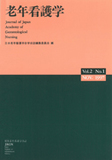Japanese
English
- 販売していません
- Abstract 文献概要
- 参考文献 Reference
本研究の目的は,痴呆性老人の転倒経過と痴呆の進行との関係を明らかにすることである.対象は,特別養護老人ホーム入所者44名で,3年間に発生した転倒をケース記録から把握した.転倒の反復性という視点から転倒経過を分類した結果,6ヵ月間に4回以上転倒した頻発群(20名),3回以下の散発群(16名),転倒なし群(8名)に分けられた.頻発群は痴呆の進行とADLの低下が他群に比して顕著であった.散発群は,転倒なし群に次いで痴呆やADLの障害が軽いが,知的機能の低下は頻発群とほぼ同じ程度であった.また,3年間の死亡者は10名(うち9名は頻発群)で,最終転倒から死亡までの間に,身体兆候や尿失禁,嚥下困難を複合させたほぼ寝たきり状態の期間が7ヵ月の範囲でみられた.
転倒の反復性を観察評価することは,痴呆の重度化を抑止するケアの創出に寄与する可能性が示唆された.
The purpose of study was to clarify the course of falls among elderly people with dementia and progression of disorders in relation to the falls. Data on cases of falls by 44 residents of a nursing home over a period of 3 years were used for the analysis. The subjects were divided into three groups according to the repeatability of falls: frequent (>4 times per 6-month) falls (n=20), occasional (<3 times) falls, and no falls (n=8). "Frequent falls" group had more advanced dementia and lower ADL than those of the other two groups. Although the state of dementia and ADL disability in "occasional falls" guoup were not severe, the progression of these was rapid. Ten of the subjects who died during the 3-year period were experienced falls (9 were in the "frequent falls" group). These subjects were bedridden for up to 7 months before death, during which time complications such as physical signs, urinary incontinece and dysphagia.
The results suggest that the frequency of falls may be a sign of atrophy.
Copyright © 1997, Japan Academy of Gerontological Nursing All rights reserved.


